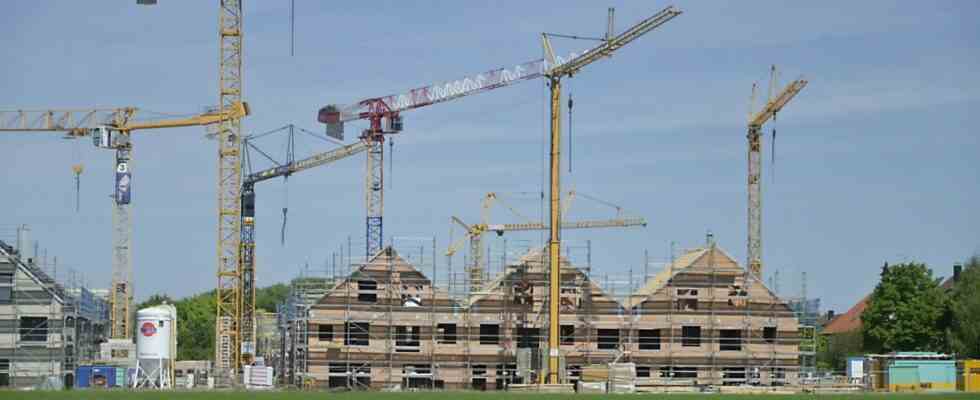Is the boom in the district of Munich over? If you look at the latest data published by the Planning Association for the Outer Economic Area of Munich (PV), you might actually think that the population movement has turned around. The numbers have been rising steadily in recent years, but then: in 2019, 350,473 inhabitants were recorded in the district, a year later there were only 349,685. But what Corona has obviously turned into a minus will be loud in the coming years The PV forecast has long since been made up for: In 2040, Bavaria’s most populous district is expected to be home to 374,000 people.
The planning association always lags behind with its publications. The second pandemic year 2021 – although history has been five months – is not included in the recently published district data. A look back at the past ten years, which is possible with these figures, shows the clear curve towards more population and more jobs in the entire region and also in the district of Munich. From 323,015 inhabitants in 2010, this has grown to almost 350,000. The fact that 2020 was a negative business was due to the noticeably fewer people moving in from abroad: instead of more than 16,000 as on average in previous years, just under 14,000 came. But 1000 more people from Germany left the district than moved in. In particular, residents between the ages of 18 and 29 and those over 50 turned their backs on the district.
The large municipalities have once again grown the most, but small Aying is at the forefront
In terms of percentage, the small community of Aying has grown the most over the past ten years, namely by 22.4 percent. 5508 residents were registered in 2020. But Aschheim is also making a big leap forward with 21.5 percent; 9,315 people now live here. Only Hohenbrunn fell back by 1.6 percent, 8815 still had their residential address here in 2020, 139 fewer than in 2010. In absolute figures, the largest municipalities have grown the most. In Unterhaching, 2,460 residents were added, the municipality now has 25,234. Unterschleißheim remains the leader with 26,824, ten years ago there were 2,408 fewer. But Ismaning and Haar have now gained more than 2000 citizens compared to 2010. Neuried (+169), Pullach (+161) and Taufkirchen (+86) recorded comparatively low population growth.
With the move, the number of employees subject to social security contributions in the city of Munich and in the surrounding area has also increased. According to the planning association, by 353,745 employees from 2010 to 2020. In percentage terms, this corresponds to growth of a good 31 percent. At 29.3 percent (2010 to 2020), the increase in the city of Munich is below that of the surrounding region (+ 33.4), but is significantly higher in absolute figures (city: 203,446, surrounding area: 150,299). 60 percent of the jobs (897,905) are in the city, 40 percent (600,943) in the surrounding area. A total of 239,983 of these are in the district of Munich.
Most jobs are in Garching, but twice as many people work in Unterföhring as live there
Most jobs are in Garching (27,642), where 13,071 have been added over the past ten years – an increase of almost 90 percent. Taufkirchen recorded an even higher growth rate of 99.1 percent. However, far fewer people work there, and the number of jobs has increased by 4,675 since 2010 to 9,391 in 2020. At the Unterföhring media location, 5,120 employees subject to social security contributions were added; 22,775 people worked here at the time of the survey a year and a half ago. This means that the labor market density is highest in the community on the northern outskirts of the city. There are 2027 employees per 1000 inhabitants. The average for the district is 686. Only in the municipality of Ottobrunn have there been fewer jobs. In 2010, almost 800 more people were employed here than in 2020 (8651).
The real estate market accounts for a large proportion of the 40.6 billion euros that were last generated in the Munich district within a year.
(Photo: Claus Schunk)
Since 2009, the gross domestic product (GDP) in the entire Munich region has increased by 50.7 percent to 202.74 billion euros. This means that almost a third of the entire Bavarian GDP (636.22 billion euros) is generated in this metropolitan area. The district of Munich accounted for 40.64 billion in 2019, ten years earlier it was 28.63. The disposable income of private households has also risen sharply. In 2009 it was a total of 8.78 billion euros and thus an average of 27,276 per inhabitant. In 2019 it added up to 11.31 billion, which meant an average of 32,274 for everyone.
The number of commuters has also increased enormously, although in 2010 there were already more people who came to work in the district of Munich than those who drove out. In 2020, 93,755 people commuted out and 29,507 within the district. 187,601 came from abroad.
The residents of Unterhaching and Ottobrunn have the least space
Housing is still scarce and expensive. In 2020, 13,550 apartments were newly built in the entire Munich region, 1,422 of them in the Munich district. Most completions were in Ismaning (197), in Höhenkirchen-Siegertsbrunn (142), Grünwald (125) and Unterhaching (118). Bringing up the rear is Putzbrunn with just one new apartment. However, the settlement and transport sector already takes up a considerable proportion of the area in some municipalities. In Ottobrunn it is 87.4 percent, in Neubiberg 72.7 and in Grünwald 68.8 percent. The situation is completely different in the smaller rural communities of Aying (7.4 percent settlement and transport area), Sauerlach (8.7) and Straßlach-Dingharting (11.9). In the latter, every resident and employee has the largest area available, namely 853 square meters. In Brunnthal there are 605 and in Aying 598. You have to move the closest together in Unterhaching (147 square meters per inhabitant), in Unterföhring (149) and in Ottobrunn (150).

